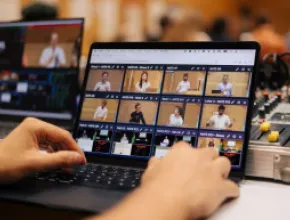1. As far as the iBeacon with mobile apps, app developers are charging far more than $10 for integration. What options do you recommend for conferences to avoid these upcharges?
We are in the infancy stages of beacon deployment. The actual cost of the beacon starts at about $10 to $50 per beacon, but the labor it will take to configure and deploy will be higher. The good news is that this should be less expensive than previous RFID technologies. Also, as things developed and become more standardized, it should become much less expensive. My advice is to do a cost/benefit analysis to determine if the specific feature(s) desired are worth the cost.
2. Can you give the voucher code again for gDoc?
Voucher code: CORBINBALL
This currently only works with PCs and iOS.
3. For the iBeacon, is that something invitees have to download, like an app, in order to receive notifications?
Yes, iBeacons interact with apps. For events, this would be the specific event app for your event.
4. Is the gDOC code case sensitive and only for PC?
Yes.
5. Have you seen any of these social media options used for surveying a group? If so, how?
I have seen Twitter being used for surveying. However, I would recommend using the polling/survey features in many event apps as a more consistent and ubiquitous survey functionality. This app could eventually be tied into beacon technology, so that everyone with the event app installed will receive a pop-up notification on their phone, which will take them directly to the poll/survey desired.
6. Can beacon technology be integrated with an event app that you may already be using?
Yes, most of the major mobile event app companies are developing beacon technology. This will be the way than most events will access this technology.
7. Have you used Hangouts? How effective are they?
Yes! Google Hangouts is a great point-to-point videoconferencing tool (with up to 10 simultaneous locations.) It is free, reliable, and does not require great computer resources. Google Hangout On Air will allow you to also stream out for webcasting at no cost and, if desired, automatically record to YouTube. Similar technologies 10 years about would have cost hundreds of thousands of dollars and satellite feeds to accomplish.
8. How do you keep value for paid event attendees while offering the same content to online attendees?
In my mind, there is no comparison. Face-to-face in-person meetings are a far richer experience. Online is great for short information exchange, but for longer sessions or for networking, brainstorming and/or relationship building, there is nothing that compares to F2F!
9. Do you have any suggestions for back-up power because of battery life?
I have a backup battery for emergencies or very long plane flights. I use Limefuel. However, since I have purchased my iPhone 6plus, it is very rare that I will run out of battery life in a full, heavy day of use.
10. How does GDoc compare with Evernote? This is a popular option, too.
GDoc is specifically designed to create paperless conference binders on iPads. Evernote is a much broader, cross-platform document management tool.
BONUS QUESTIONS!
11. How much time do you spend curating and looking at others social media content, then creating your own?
Social media can be a huge time sink, although a very helpful communications tool. Although I am active on all the social channels, I try to budget my time to no more than 30 minutes per day. I do this through using process efficiency and using content aggregation tools such as Hootsuite.com.
12. I am reading more and more about the negative effects that EMFs can have on our health. It is a little worrying seeing the use of cellular devices becoming more and more infiltrated in our lives. It is especially disturbing to see children uses devices at 1 year of age. It seems that this is not being discussed in the tech industry...or it is being ignored. Do you see that ever changing?
We are constantly immersed in radio waves. Visible light is simply part of the broad electromagnetic spectrum. However, there have been some studies that indicate cell phone radiation can be hazardous. Others studies indicate that they are safe. The jury is out. The chances are that, if there is a hazard, it is cumulative--the longer the exposure, the greater the risk. If I was a parent of a young child, I would seek to limit exposure (especially intense exposure such as with a mobile phone pressed up to one's head) until more data is in. Using headphoneS can help.
13. Mobile event apps are pretty expensive for small companies. Do you see the price going down?
The price has come down substantially over the past three years. Currently there is a price range that ranges from free to more expensive, very customized high-end products. See http://www.corbinball.com/bookmarks/#mguide for a wide range of options.
14. On the hotel side, what would we need to have in place to be able to offer these apps?
Especially for recurring customers, mobile apps provide the opportunity to engage clients before, during and after stays. I think that Html5 apps (Web pages that act and can be saved you your mobile desktop and act like apps) that do not require a specific download from an app store will be used much more widely.






